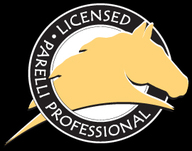I originally wrote this article for the Savvy Times and am now including it here since it has already appeared in the magazine.
Graceful, seemingly effortless riding on a responsive, eager horse is both a joy to experience and a joy to watch. Getting there, however, takes time and, as Pat says, "perfect practice." One of the keys to that successful practice is to develop excellence in the Freestye riding Savvy--and one of the keys to success with that is to get very comfortable and effective with Carrot Stick riding. Whether your dream is to ride bareback and bridle-less or to win the dressage competition, whether it's to trail ride for fun with friends and family or to make the reining or cutting championships, turn that Carrot Stick into your best friend.
My computer continually rotates photographs across my screen as I work, and I've come to appreciate how many hundreds, even thousands, of photos of Carrot Stick riding I've accumulated over the years. Either I'm teaching a clinic or developing my own horsemanship--either way, the photos frequently show us students in some stage of learning to ride with sticks. Sometimes we're having fun, sometimes we're concentrating very hard, sometimes we're clearly in learning mode. Other times, the wonderful results splash across the screen.
"Don't make me pick up that stick!" You probably have heard Pat or Linda, or your instructor, say something like this. We're all familiar, when playing on the ground, with the idea of using the stick, as an extension of one's self, to communicate with our horses when they don't quite understand what we're offering or suggesting with phase 1. The same goes for Freestyle riding. When we use the stick while riding, we're playing the Driving Game with it and using that rhythmic pressure to help our horses understand how to follow the focus and feel we're offering with our energy, our bodies, seat, legs, hands. Once Friendly Game (confidence, calmness, and trust) are in place, the Porcupine Game is the game that matters most when we ride. I'd like never to have to go beyond phase 1 or 2 of steady pressure ("follow a feel") with any part of my body when I ask my horse to go, stop, back, turn.
Yet, horses, some more than others, tend by nature to lean into steady pressure rather than turn loose to it,. Fortunately, again by nature, they tend to be quite responsive to rhythmic pressure. We can use these facts to our advantage to teach our horses to respond willingly, happily, athletically to our polite and clear steady pressure. Adding a bit of Driving Game to our Porcupine Game enhances the latter and develops in our horses greater connection and responsiveness. It also enhances our leadership, leading to a more solid, more harmonious partnership.
In other words, horses tend to "brace" against steady pressure, especially if we inadvertently first offer that pressure too abruptly or with too much, well, pressure. As Pat says, we should have two ounces of pressure in our hands, 4 ounces in our legs, and then a ton of Focus! Add to this mix the rhythmic pressure of your Carrot Stick and you will develop responsiveness to the most subtle cues. The rhythm of the stick as you bring it into play helps prevent your horse from reacting to you with a brace (tension and stiffness) in the first place. (In a perfect world, we'd all have the hands and seat--and timing, feel, and balance--to never create any brace.) And, if she's already gone there, the rhythmic pressure will help her let it go. Zero brace is our goal with everything we do with our horses. But most of us do encounter brace in our horses and ourselves, either as a result of our predator psychology (hands and legs that "grab"), our mistakes as we learn, our horses' past learning, their prey animal psychology. Horses can also "lean" on a mental or emotional brace in us such as frustration or discouragement; they can resist yielding happily to our direction if our intention and energy ("life up, life down") are too little, too much, or just simply not clear.
The Levels pathway offers a good guide to introducing and using the Carrot Stick when riding Freestyle. Learn in Level 2 to carry it, play FG with it while mounted, and use it in phases to support "eyes, belly-button, leg, and rein" when you guide your horse. When we use the stick while riding, it itself is phase 4, coming into play after those eyes, belly-button, and leg. Within that phase 4, however, are more phases. Neutral is on your shoulder; phase 1 happens when you bring the stick off your shoulder in the 3 o'clock or 9 o'clock position, phase 2 occurs when you rhythmically move the stick toward your horse, phase 3 happens when you add energy to the rhythm and get closer, phase 4 is when you make rhythmic contact. And within that phase 4 are more phases! You can tap lightly or add energy and change the cadence the next time, just as the alpha mare changes up her game when using her driving game to maintain her leadership. The human tendency, because we don't want to be mean or hard, is to renege on our promise to be clear and not use the Carrot Stick's driving game effectively and fairly. As I sometimes tell my students, allow your alpha mare named Carrot to do her job!
The stick also helps us be in the right position, to be aware of and use those natural riding dynamics. Our horses are naturally very sensitive to our changes of focus, of energy, shifts of our weight, applications and releases of the slightest pressure in seat, legs, hands. It's natural for them to do in their bodies what we do in ours. As you and your horse gain confidence, you can begin to use the stick to support your focus and body without any reins. As Pat says, a horse can go six different ways besides stand still: backwards, forward, right, left, up, and down. You can and should use the stick to support what your energy, focus, and body when you ask your horse to do any and all of these things. When you do so, presto, you're riding bridle-less!
In the beginning, rhythmically using the stick to support Direct Rein turns--in other words, to ask the front end to move over--is perhaps the easiest. But don't stop there. Use the stick to develop your horse's responsiveness to your Indirect Rein, to your requests to go sideways, to stop, and back up. Progress to using two sticks, which you'll probably be ready for in Level 3. Then in Level 4 move on to the "truth"--truly bridle-less riding with one stick (and neck string if you wish) as your safety net and support.
So much of what we ask our horses to do with athleticism and grace depends on fantastic hind quarter control. Riding with Carrot Sticks can help you develop this to a point where it feels like anything is possible. Anything, from neutral lateral flexion to trotting sideways to cantering the cloverleaf pattern to galloping over jumps, that you can do without sticks you and your horse can do with them--with enormously gratifying results. Bridle-less or not, going straight, a nice turn on the haunches, flying lead changes, lateral movements, a beautiful walk, slide stops--all depend on a high level of responsiveness to your leadership and communications. Your alpha mare named Carrot is waiting to help you!
My computer continually rotates photographs across my screen as I work, and I've come to appreciate how many hundreds, even thousands, of photos of Carrot Stick riding I've accumulated over the years. Either I'm teaching a clinic or developing my own horsemanship--either way, the photos frequently show us students in some stage of learning to ride with sticks. Sometimes we're having fun, sometimes we're concentrating very hard, sometimes we're clearly in learning mode. Other times, the wonderful results splash across the screen.
"Don't make me pick up that stick!" You probably have heard Pat or Linda, or your instructor, say something like this. We're all familiar, when playing on the ground, with the idea of using the stick, as an extension of one's self, to communicate with our horses when they don't quite understand what we're offering or suggesting with phase 1. The same goes for Freestyle riding. When we use the stick while riding, we're playing the Driving Game with it and using that rhythmic pressure to help our horses understand how to follow the focus and feel we're offering with our energy, our bodies, seat, legs, hands. Once Friendly Game (confidence, calmness, and trust) are in place, the Porcupine Game is the game that matters most when we ride. I'd like never to have to go beyond phase 1 or 2 of steady pressure ("follow a feel") with any part of my body when I ask my horse to go, stop, back, turn.
Yet, horses, some more than others, tend by nature to lean into steady pressure rather than turn loose to it,. Fortunately, again by nature, they tend to be quite responsive to rhythmic pressure. We can use these facts to our advantage to teach our horses to respond willingly, happily, athletically to our polite and clear steady pressure. Adding a bit of Driving Game to our Porcupine Game enhances the latter and develops in our horses greater connection and responsiveness. It also enhances our leadership, leading to a more solid, more harmonious partnership.
In other words, horses tend to "brace" against steady pressure, especially if we inadvertently first offer that pressure too abruptly or with too much, well, pressure. As Pat says, we should have two ounces of pressure in our hands, 4 ounces in our legs, and then a ton of Focus! Add to this mix the rhythmic pressure of your Carrot Stick and you will develop responsiveness to the most subtle cues. The rhythm of the stick as you bring it into play helps prevent your horse from reacting to you with a brace (tension and stiffness) in the first place. (In a perfect world, we'd all have the hands and seat--and timing, feel, and balance--to never create any brace.) And, if she's already gone there, the rhythmic pressure will help her let it go. Zero brace is our goal with everything we do with our horses. But most of us do encounter brace in our horses and ourselves, either as a result of our predator psychology (hands and legs that "grab"), our mistakes as we learn, our horses' past learning, their prey animal psychology. Horses can also "lean" on a mental or emotional brace in us such as frustration or discouragement; they can resist yielding happily to our direction if our intention and energy ("life up, life down") are too little, too much, or just simply not clear.
The Levels pathway offers a good guide to introducing and using the Carrot Stick when riding Freestyle. Learn in Level 2 to carry it, play FG with it while mounted, and use it in phases to support "eyes, belly-button, leg, and rein" when you guide your horse. When we use the stick while riding, it itself is phase 4, coming into play after those eyes, belly-button, and leg. Within that phase 4, however, are more phases. Neutral is on your shoulder; phase 1 happens when you bring the stick off your shoulder in the 3 o'clock or 9 o'clock position, phase 2 occurs when you rhythmically move the stick toward your horse, phase 3 happens when you add energy to the rhythm and get closer, phase 4 is when you make rhythmic contact. And within that phase 4 are more phases! You can tap lightly or add energy and change the cadence the next time, just as the alpha mare changes up her game when using her driving game to maintain her leadership. The human tendency, because we don't want to be mean or hard, is to renege on our promise to be clear and not use the Carrot Stick's driving game effectively and fairly. As I sometimes tell my students, allow your alpha mare named Carrot to do her job!
The stick also helps us be in the right position, to be aware of and use those natural riding dynamics. Our horses are naturally very sensitive to our changes of focus, of energy, shifts of our weight, applications and releases of the slightest pressure in seat, legs, hands. It's natural for them to do in their bodies what we do in ours. As you and your horse gain confidence, you can begin to use the stick to support your focus and body without any reins. As Pat says, a horse can go six different ways besides stand still: backwards, forward, right, left, up, and down. You can and should use the stick to support what your energy, focus, and body when you ask your horse to do any and all of these things. When you do so, presto, you're riding bridle-less!
In the beginning, rhythmically using the stick to support Direct Rein turns--in other words, to ask the front end to move over--is perhaps the easiest. But don't stop there. Use the stick to develop your horse's responsiveness to your Indirect Rein, to your requests to go sideways, to stop, and back up. Progress to using two sticks, which you'll probably be ready for in Level 3. Then in Level 4 move on to the "truth"--truly bridle-less riding with one stick (and neck string if you wish) as your safety net and support.
So much of what we ask our horses to do with athleticism and grace depends on fantastic hind quarter control. Riding with Carrot Sticks can help you develop this to a point where it feels like anything is possible. Anything, from neutral lateral flexion to trotting sideways to cantering the cloverleaf pattern to galloping over jumps, that you can do without sticks you and your horse can do with them--with enormously gratifying results. Bridle-less or not, going straight, a nice turn on the haunches, flying lead changes, lateral movements, a beautiful walk, slide stops--all depend on a high level of responsiveness to your leadership and communications. Your alpha mare named Carrot is waiting to help you!

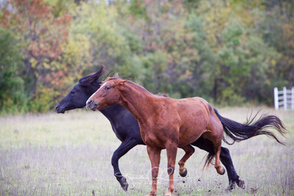
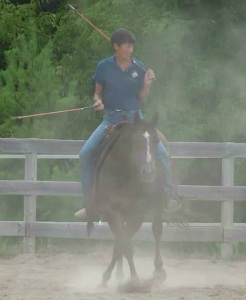
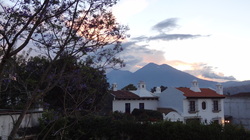
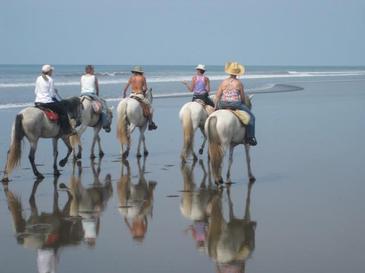
 RSS Feed
RSS Feed

